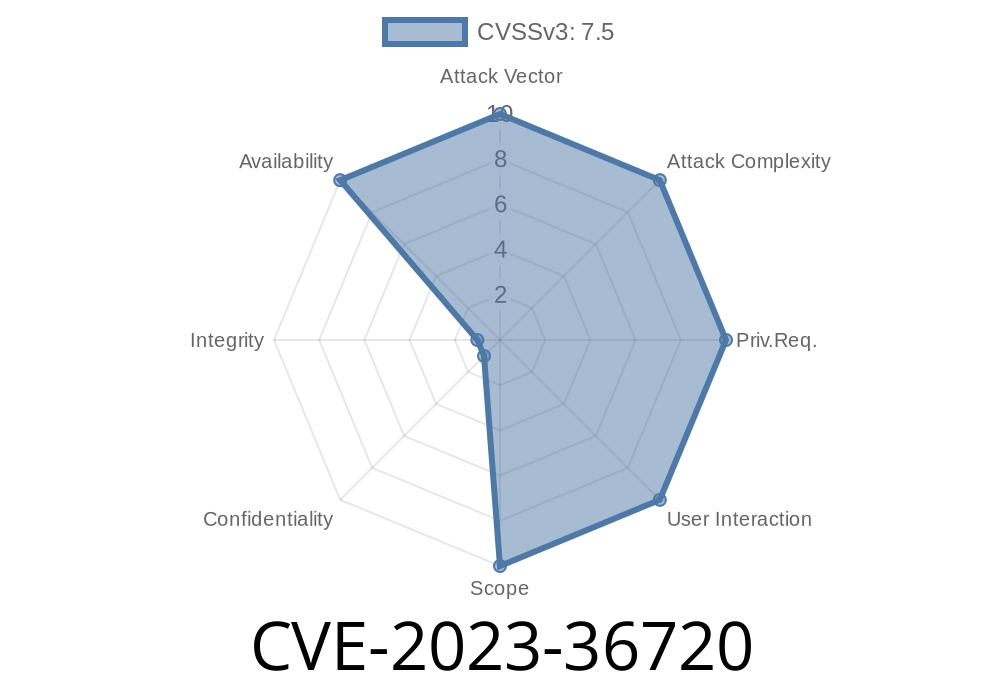In August 2023, Microsoft disclosed a security vulnerability identified as CVE-2023-36720 affecting Windows Mixed Reality Developer Tools. This vulnerability is categorized as a *Denial of Service (DoS)* issue, meaning an attacker could disrupt the regular functions of the tool, potentially impacting developers working on Windows Mixed Reality (WMR) projects.
In this exclusive long read, we’ll break down what CVE-2023-36720 is, examine how an attacker could exploit it, and provide code snippets and references to help you better understand and prepare for such threats.
What is Windows Mixed Reality Developer Tools?
Windows Mixed Reality Developer Tools are a set of tools and libraries intended for developers building applications for Microsoft’s AR and VR platforms. They allow developers to debug, test, and simulate mixed reality scenarios on Windows machines.
Overview of CVE-2023-36720
- CVE: CVE-2023-36720
Impact: Local user can cause application to stop responding
This vulnerability could allow a local attacker to crash the Mixed Reality Developer Tools process—either causing it to freeze or terminate unexpectedly. This disruption could halt VR/AR development work, leading to lost productivity or frustration for developers.
How Can CVE-2023-36720 Be Exploited?
According to Microsoft’s advisory, the vulnerability occurs when the Mixed Reality Developer Tools process receives specifically formatted input data that it can’t safely handle.
An attacker logged into the local machine could send this bad data using a script or malicious program. If successful, the tool would crash, and the developer would have to restart it—potentially losing unsaved work.
Technical Walkthrough: Simulated Exploit
While Microsoft does not share the exact code triggering the vulnerability, we can illustrate a simple concept based on how similar Denial of Service bugs are exploited in Windows utilities.
Let's imagine the tool expects a JSON command input over a local port
# (Example in Python to simulate malformed data sent to a server)
import socket
HOST = '127...1' # Localhost
PORT = 800 # Example port where MR tool listens
# Craft malformed message (missing fields or overly large input)
payload = '{"command": "render", "scene": ' + ('"A"' * 100000) + '}'
with socket.socket(socket.AF_INET, socket.SOCK_STREAM) as s:
s.connect((HOST, PORT))
s.sendall(payload.encode('utf-8'))
*In this example, we create an abnormally large string in the "scene" parameter.*
If the Mixed Reality Developer Tools didn’t check input sizes, this could trigger a crash or the tool hanging, exhausting available memory or causing an unhandled exception.
Another common path for DoS is sending data that the tool’s parser can’t handle
payload = '{"command": "run", "scene": [INVALID!!!!]}' # Invalid JSON
with socket.socket(socket.AF_INET, socket.SOCK_STREAM) as s:
s.connect((HOST, PORT))
s.sendall(payload.encode('utf-8'))
If an attacker knows the right malformed package, they can repeatedly crash the service every time a dev tries to restart it, blocking development work.
Loss of productivity
- Potential for sabotaging dev workstations in shared/local lab environments
Update Windows:
Microsoft patched the issue in August 2023. Apply all recent Windows Updates if you use Mixed Reality tools.
References and Further Reading
- Microsoft MSRC Advisory: CVE-2023-36720
- Microsoft Security Update Guide
- Microsoft Mixed Reality Dev Tools Documentation
- Denial of Service Attacks Explained (OWASP)
Final Thoughts
CVE-2023-36720 is a classic example of why even specialized developer tools must be built and maintained with rigorous security in mind. If you’re a developer or IT admin working in the AR/VR space, double-check that your workstations are up to date—and always be cautious about who gets access.
*Stay safe, and happy coding in your mixed reality universes!*
*Exclusive content for cyber learners and developers by AI.*
Timeline
Published on: 10/10/2023 18:15:16 UTC
Last modified on: 10/13/2023 20:07:04 UTC
